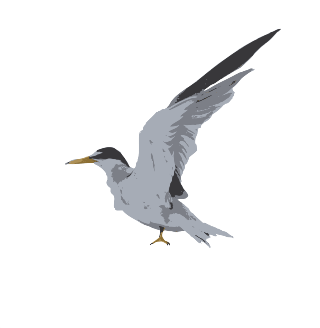There are four offshore barrier islands, located 10-12 miles south of the Mississippi mainland, that define the southern boundary of the Mississippi Sound. One of these (Ship Island) was split by Hurricane Betsy in 1965 and widened by Hurricane Camille in 1969 into an east and west component. A fifth near-shore island (Deer Island) is also included here. All of these sites are basically similar in habitat and birdlife, although birding potential may vary. A regularly scheduled passenger boat service (Ship Island Excursions) is available to West Ship Island from March through October. Access to this and other islands can also be achieved through private or chartered vessels Click here for complete information or visit our Resources page. Visitors considering the last two modes need to consult the Guide to Mississippi Barrier Islands that contains much valuable information including GPS waypoints and information about areas that are open to the public and are easy to access.
Except for a few private inholdings, most of the four offshore islands are owned and managed as part of the Gulf Island National Seashore. They are all also designed as Mississippi Coastal Preserves by the Mississippi Department of Marine Resources. The near-shore Deer Island is owned and managed primarily by the Mississippi Department of Marine Resources. All of the islands are recognized by the National Audubon Society as Important Bird Areas (IBA). All islands are publically accessible, and the federal and state managing agencies continue to seek acquisition of the remaining non-public holdings. These long, linear islands largely consist of a series of dunes and swales that provide high and low points that support scrub vegetation on the high ridges, and lagoons and marshes in the valleys. Maritime forest, consisting of Slash Pine, Dwarf Live Oak and Myrtle-leaf Oak exist to varying extent on the offshore islands and dominate Deer Island. The south sides of the offshore islands consist of broad natural sand beaches and sandbars. The north shores consist of interspersed mudflats and tidal marshes, with submerged seagrass beds.
A number of breeding birds of interest are more or less generally distributed through the islands. Among them are Osprey, American Bald Eagle, American Oystercatcher, Snowy and Wilson’s Plovers, (Eastern) Willet, Royal, Sandwich, Gull-billed and Least Terns, Black Skimmer and Seaside Sparrow. Frequent non-breeding summer visitors include Magnificent Frigatebird, Reddish Egret and numbers of Black Terns. The latter are mostly 1st year birds that stop off here on their journey north from their wintering grounds rather than continuing on to the northern nesting grounds. In winter, Northern Gannets are common, mostly over the open waters of the Gulf, and a variety of water birds can be found in the Mississippi Sound, including Common Goldeneye, Long-tailed Duck, a scattering of scoters and rafts of Redhead and both species of scaup. Some of the rarities that have been found on the islands in winter are: Pacific Loon, Glaucous Gull, Thayer’s Gull, Burrowing Owl and Lapland Longspur. However, it is migration time that both captivates and frustrates the birder. The islands are superb migrant traps but at best, visiting can be logistically complicated. This, coupled with the fact that the weather conditions producing major fallouts are not those best suited for safe navigation of the small, shallow-draft vessels necessary for beach landings, leads to a classic Catch-22. However those that have succeeded have been amply rewarded.

Website -Mozart Mark Dedeaux
Birding Ethics
Contact Us
Website Feedback
New Trail Nomination
Updated: 9/17/2013











